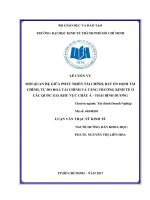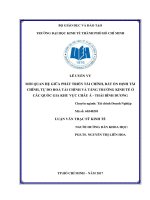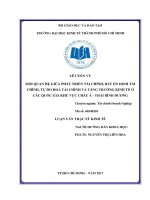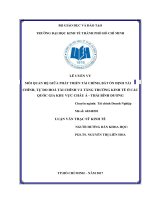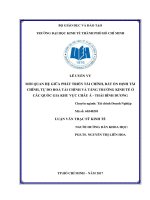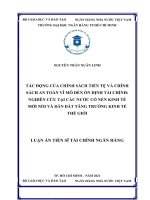Các yếu tố tác động đến sự ổn định tài chính của các ngân hàng thương mại việt nam
Bạn đang xem bản rút gọn của tài liệu. Xem và tải ngay bản đầy đủ của tài liệu tại đây (2.28 MB, 113 trang )
<span class="text_page_counter">Trang 4</span><div class="page_container" data-page="4">
<b>ABSTRACT </b>
The research was conducted with the purpose of identifying factors that impact the financial stability of Vietnamese commercial banks. Research data was collected from 23 Vietnamese commercial banks in the period 2010 - 2022. The study used a set of methods such as descriptive statistics, correlation matrix, panel data regression, least squares estimation feasible generalized minimum, GMM regression and use of Z-score to comprehensively review the topic and obtain optimal results. Thanks to the support of STATA 17.0 software, the author obtained research results showing 7 factors that impact the financial stability of Vietnamese commercial banks including: (1) Capital adequacy ratio; (2) Return on equity ratio; (3) Net profit margin; (4) Bank size; (5) Ratio of outstanding loans to total assets; (6) Inflation; (7) Growth rate. Based on the results obtained, the author proposes some management implications to help policymakers, administrators as well as banks to improve or maintain financial stability.
<i>Keywords: financial stability, Commercial Bank, Z-score </i>
</div><span class="text_page_counter">Trang 14</span><div class="page_container" data-page="14"><b> I THI U T NG QUAN VỀ NGHIÊN CỨU </b>
</div><span class="text_page_counter">Trang 19</span><div class="page_container" data-page="19">ng tài s n. Z-score càng l n hàm ý s nh tài chính càng cao hay r i ro t ng
</div><span class="text_page_counter">Trang 22</span><div class="page_container" data-page="22">(Asghar Kamal, Talat Hussain, M. Mahmood Shah Khan, 2021) ng n u ki th ng tài chính, bao g m các trung gian tài
</div><span class="text_page_counter">Trang 23</span><div class="page_container" data-page="23">nh tài chính s m b o n sau: (i) Bong bong giá tài s n; (ii) Thi u thanh kho n; (iii) Tình tr a các th ch a s n công c ng, n u khơng thì vi y nh tài chính s không ph i là m c tiêu x a chính sách cơng. S nh tài chính ph i ch u s ki m soát ho c ng c n (William A. Allen, Geoffrey Wood, 2006).
</div><span class="text_page_counter">Trang 24</span><div class="page_container" data-page="24">chính c x y ra khi các ngân hàng th t ch t ng t các u ki n vay v n. Lai (2002) cho r n c a s b t n tài chính ngân hàng là s m i gi a tài s n và v n ngân hàng khi n ph i tr ngân kho n th p, d n kh ng ho ng thanh kho n khi nhu c u thanh toán ng n h n t quá d tr tài s n có tính thanh kho William A. Allen, Geoffrey Wood (2006) t tr n b t n tài chính khó có th x i lo s v b t n tài chính khơng ph i là y u t tr ng y u trong các quy nh kinh t ia (Omondi Godfrey ODUNDO, Maengwe James ORWARU, 2018)
</div><span class="text_page_counter">Trang 26</span><div class="page_container" data-page="26">ng l i nhu n trên tài s n s th c hi n nghiên c u v n x u và s nh tài chính c a các ngân hàng Kenya và k t lu n r ng các kho n vay không hi u qu i Kenya nh
</div><span class="text_page_counter">Trang 27</span><div class="page_container" data-page="27">u tài s n và có th ph n ánh s thành công trong vi c qu n lý tài s n sinh l i c a ngân hàng. Biên lãi ròng l n cho th n lý thành công tài s n sinh lãi c a mình. Ngồi ra, biên lãi ròng ph n ánh c ãi su t và (Adusei, 2015). Có th th y, các ngân hàng l n có ti m l c tài chính và ngu n l c m n, có th c kinh doanh v cung c p các s n ph m tín
</div><span class="text_page_counter">Trang 29</span><div class="page_container" data-page="29">(Dimas Mateus Fazioa, Thiago Christiano Silvab, Benjamin Miranda Tabakd, Daniel Oliveira Cajueiroe, 2018) Muhammad Ali Shahid, Zaheer Abbas (2012)
</div><span class="text_page_counter">Trang 30</span><div class="page_container" data-page="30">(Yong Tan, Christos Floros, 2012). Theo Naama Trad, Houssem Rachdi, Abdelaziz Hakimi, Khaled Guesmi (2016), Muhammad Ali Shahid, Zaheer Abbas (2012)
</div><span class="text_page_counter">Trang 31</span><div class="page_container" data-page="31">(Bilal Hafeez, Xiping Li b, M. Humayun Kabir, David Tripe, 2022 Abu Hanifa Md. Noman, Chan Sok Gee, Che Ruhana Isa, 2017) - l l ch chu n c a l i nhu n mà n u giá tr l i nhu n ROA k v ng c a ngân hàng gi m xu ng theo s l y v n ch s h u s b c n ki t và ngân hàng m t kh Luc Laeven, Ross
</div><span class="text_page_counter">Trang 35</span><div class="page_container" data-page="35">m i và thu nh p ngoài lãi có h s p ngoài lãi và l n rõ r t v i m i quan h nhân qu kép gi a s n
</div><span class="text_page_counter">Trang 36</span><div class="page_container" data-page="36">
Muhammad Ali, Chin Hong Puah (2018). Các y u t nh kh i và s nh c a ngân hàng. M m tra các y u t bên trong quy nh kh i và s nh c a ngân hàng trong khu v i - t qu thu c t mơ hình l i nhu n ch ra r ng quy mô ngân hàng, r i ro tín d ng, r i ro tài chính và s v m t th n l i nhu n, trong khi r i ro thanh kho n cho th v m t th n l i nhu t s hi u bi t m i h u ích cho các ngân hàng. M t s khuy n ngh có th h u ích cho ho ng b n v ng c a ngân hàng.
<b> </b>
Le (2020) i liên h gi ng cho vay, kh l i và s nh trong h th ng ngân hàng Vi t Nam t nh quan h nhân qu Granger, - y m i quan h hai chi u gi a s nh c a ngân hàng, l i
</div><span class="text_page_counter">Trang 55</span><div class="page_container" data-page="55"><b> 4. K t qu ng mơ hình Pooled OLS, FEM và REM </b>
OLS & FEM FEM & REM OLS & REM
</div><span class="text_page_counter">Trang 56</span><div class="page_container" data-page="56"><i> T ng h p d a trên k t qu phân tích thơng qua STATA 17.0 </i>
<b> - test thông qua B </b>
</div><span class="text_page_counter">Trang 58</span><div class="page_container" data-page="58"><b>Number of obs = 299 Wald chi2(8) = 804.49 Number of groups = 23 Prob > chi2 = 0.0000 </b>
</div><span class="text_page_counter">Trang 61</span><div class="page_container" data-page="61">Group variable: codeMH Number of obs = 276 Time variable: year Number of groups = 23 Number of instruments = 21 Obs per group: min = 12
</div><span class="text_page_counter">Trang 67</span><div class="page_container" data-page="67">(Liisa Halme, Christian Hawkesby, Juliette Healey, Indrek Saapar and Farouk Soussa, 2000)
</div><span class="text_page_counter">Trang 74</span><div class="page_container" data-page="74">M r ng m i v i nhi u chi nhánh m t cách giúp ngân c này không ch giúp ti p c c nhi mà cịn giúp ích trong vi c t o lịng tin c a cơng chúng v hình nh c a ngân hàng. y tên c a m s l i d u nh n di u n g n v ng th i s ng dành cho ngân
</div><span class="text_page_counter">Trang 75</span><div class="page_container" data-page="75">ng ngân hàng t t, uy tín m i to l n có m t kh p y, khi n h d dàng trong quy nh g i ti n hay s d ng nhi u d ch v ngân hàng cung c p. T n cho ho ng kinh doanh hi u qu , giúp ngân hàng
Ngoài ra, vi c mua bán, sáp nh g quy mô. Vi c ngân hàng th c hi n mua bán sáp nh p khi n ngân hàng t o ra m t t ch c v i quy mô l ng v c các ngân hàng sáp nh p s giúp c t gi c nhi u chi phí, nh ng ngân hàng có cùng a bàn ho n c c t gi m, t t gi c chi phí nhân viên, m t b ng, chi phí ho ng c a chi nhánh,... Nh ng ngân hàng khi ho ng riêng l ng khách hàng riêng và nh ng d ch v p nó s b tr cho nhau giúp m r ng ng hóa ho ng kinh doanh khi n ngân hàng ngày càng nh.
Tuy quy mơ l n có th mang l i nh ng l i ích nh i nó là ph i ki m soát ch t ch nh ng r i ro m t cách th n tr r ng m i khơng h p lí s i gánh n qu c nh ng ngân hàng có quy mơ l n b i t m quan tr ng mang tính h th ng. Nh ng ngân hàng có quy mơ l n n v s lây lan sang nh ng ngân hàng khác, th m chí ng c n n kinh t . Nh ng ngân hàng này c n có s giám sát ch t ch , toàn di
</div><span class="text_page_counter">Trang 80</span><div class="page_container" data-page="80"><b> </b>
<i>Abu Hanifa Md. Noman, Chan Sok Gee, Che Ruhana Isa. (2017). Does competition improve financial stability of the banking sector in ASEAN countries? An empirical analysis. </i>
Adusei, M. (2015). The impact of bank size and funding risk on bank
<i>stability. Cogent Economics & Finance, 3: 1111489. </i>
Aerdt Houben, Jan Kakes, and Garry Schinasi. (2004). Toward a Framework
<i>for Safeguarding Financial Stability. IMF Working Paper WP/04/101. </i>
Aerdt Houben, Jan Kakes, Garry Schinasi. (2004, 6). Toward a Framework
<i>for Safeguarding Financial Stability. IMF Working Paper WP/04/101. Retrieved </i>
from IMF Working Paper WP/04/101.
Ali Mirzaei, Tomoe Moore, Guy Liu. (2013). Does market structure matter
<i>on ’ Journal of Banking & Finance 37, 2920-2937. </i>
Allen N. Berger, Leora F. Klapper, Rima Turk-Ariss. (2009). Bank
<i>Competition and Financial Stability. J Financ Serv Res, 99-118. </i>
Ameni Ghenimi, Hasna Chaibi, Mohamed Ali Brahim Omri. (2017). The effects of liquidity risk and credit risk on bank stability: Evidence from the MENA
<i>region. Borsa Istanbul Review, 17(4), 1-11. </i>
Ariss, R. T. (2010). On the implications of market power in banking:
<i>Evidence from developing countries. Journal of Banking & Finance 34, 765–775. </i>
Asghar Kamal, Talat Hussain, M. Mahmood Shah Khan. (2021). Impact of
<i>financial inclusion and financial stability: Empirical and theoretical review. Liberal Arts & Social Sciences International Journal, 5(1), 510-524. </i>
Bilal Hafeez, Xiping Li b, M. Humayun Kabir, David Tripe. (2022).
<i>Measuring bank risk: Forward-looking z-score. International Review of Financial Analysis. </i>
<i>Chant, J. (2003). Financial Stability as a Policy Goal (Vol. No. 95). Canada. </i>
</div><span class="text_page_counter">Trang 81</span><div class="page_container" data-page="81">Chi, L. H. (2022, 10 13). M i quan h gi a quy mô và hi u qu tài chính các
<i> i Vi t Nam. </i>
// / -quan-he-giua-quy-mo-va-hieu-qua-tai-chinh-cac-ngan-hang-thuong-mai-viet-nam.htm
Cristian BARRA, Roberto ZOTTI. (2018). BANK PERFORMANCE, FINANCIAL STABILITY AND MARKET CONCENTRATION: EVIDENCE
<i>FROM COOPERATIVE AND NON-COOPERATIVE BANKS. Annals of Public and Cooperative Economics, 1-37. </i>
Dayong Zhang, Jing Cai, David G. Dickinson, Ali M. Kutan. (2015). Non-performing loans, moral hazard and regulation of the Chinese commercial banking
<i>system. Journal of Banking & Finance. </i>
Dimas Mateus Fazioa, Thiago Christiano Silvab, Benjamin Miranda Tabakd, Daniel Oliveira Cajueiroe. (2018). Inflation targeting and financial stability: Does
<i>the quality of institutions matter? Economic Modelling, 0264-9993. </i>
Faten Ben Bouhenia, Amir Hasnaoui. (2017). Cyclical behavior of the
<i>financial stability of eurozone commercial banks. Economic Modelling. </i>
Frugier,A,.2016 Returns, volatility and investor sentiment: Evidence from
<i>European stock markets. Research in International Business and Finance, Volume </i>
38, pp. 45-55.
anks and Financial
<i>Stability. IMF Working Paper. </i>
</div><span class="text_page_counter">Trang 82</span><div class="page_container" data-page="82">Irum Saba, Rehana Kouser, Rehana Kouser. (2012). Determinants of
<i>nonperforming loans: The case of the US banking industry. Economic Journal. </i>
Khawla Bourkhis, Mahmoud Sami Nabi. (2013). Islamic and conventional
<i>banks' soundness during the 2007–2008 financial crisis. Review of Financial Economics 22, 68-77. </i>
Kumar, V. (2012). Evaluating the financial performance and financial
<i>stability of national commercial banks in the UAE. Int. J. Business and Globalisation, Vol. 16, No. 2. </i>
Kyriaki Kosmidou, Fotios Pasiouras, Angelos Tsaklanganos. (2007). Domestic and multinational determinants of foreign bank profits: The case of Greek
<i>banks operating abroad. Journal of Multinational Financial Management, 17(1), </i>
1-15.
<i>Lam, C. (2021). D a nào cho ngân hàng c i thi n NIM? Retrieved from </i>
VIETSTOCK:
Laura Chiaramonte, Federica Poli and Marco Ercole Oriani. (2013). Are Cooperative Banks a Lever for Promoting Bank Stability? Evidence from the
<i>Recent Financial Crisis in OECD Countries. European Financial Management, Vol. 9999, No. 9999, 1-33. </i>
Lê Ng c Qu nh Anh, Nguy n Quý Qu c, Lê Th CÁC NHÂN TỐ ƯỞ ẾN SỰ ỊNH TÀI CHÍNH C A CÁC
<i> À ƯƠ ẠI VIỆT NAM. T p chí Khoa họ i học Hu : Kinh t và Phát tri n, 129(5B), 95–107. </i>
<i> . </i>
Le, T. D. (2020). The interrelationship among bank profitability, bank
<i>stability, and loan growth: Evidence from Vietnam. Cogent Business & Management, 7: 1840488. </i>
</div><span class="text_page_counter">Trang 83</span><div class="page_container" data-page="83">Leila Bateni, Hamidreza Vakilifard, Farshid Asghari. (2014). The Influential
<i>Factors on Capital Adequacy Ratio in Iranian Banks. International Journal of Economics and Finance, 6(11). </i>
Liisa Halme, Christian Hawkesby, Juliette Healey, Indrek Saapar and Farouk
<i>Soussa. (2000). Financial Stability and Central Banks SELECTED ISSUES FOR FINANCIAL SAFETY NETS AND MARKET DISCIPLINE. London: the Centre for </i>
Central Banking Studies, Bank of England, London.
Luc Laeven, Ross Levine. (2009). Bank governance, regulation and risk
<i>taking. Journal of Financial Economics 93, 259–275. </i>
<i>An Empirical Analysis. Journal of Financial Services Research, 38, 95–113. </i>
Banks and Financial Stability:
<i>An Empirical Analysis. IMF Working Paper WP/08/16. </i>
Mishkin, F. S. (1999). Global Financial Instability: Framework, Events,
<i>Issues. JOURNAL OF ECONOMIC PERSPECTIVES, VOL. 13, NO. 4, 3-20. </i>
Mohamed Sami Ben Alia, Timoumi Intissarb, Rami Zeitun. (2016). Banking Concentration and Financial Stability New Evidence from Developed and
<i>Developing Countries. Eastern Economic Journal, 1-18. </i>
Morozova Irina Anatolyevna and Sahabutdinova Liliya Ramilevna. (2013).
<i>Financial Stability Concept: Main Characteristics and Tools. World Applied Sciences Journal, 22(6), 856-858. </i>
Muhammad Ali Shahid, Zaheer Abbas. (2012). Financial stability of Islamic
<i>banking in Pakistan: An empirical study. African Journal of Business Management, 6(10), 3706-3714. </i>
Muhammad Ali, Chin Hong Puah. (2018). The internal determinants of bank
<i>profitability and stability: An insight from banking sector of Pakistan. Management Research Review, 2040-8269. </i>
</div><span class="text_page_counter">Trang 84</span><div class="page_container" data-page="84">Naama Trad, Houssem Rachdi, Abdelaziz Hakimi, Khaled Guesmi. (2016). Banking Stability in the MENA Region during the Global Financial Crisis and the
<i>European Sovereign Debt Debacle. The Journal of Risk Finance. </i>
Nguy n Th n Th Thu Huy n. (2022, 1 1). NGHIÊN CỨU CÁC NHÂN TỐ ƯỞ ẾN SỰ ỊNH TÀI CHÍNH C A CÁC
<i> À ƯƠ ẠI TẠI VIỆT NAM. FTU Working Paper Series, Vol </i>
Omondi Godfrey ODUNDO, Maengwe James ORWARU. (2018). Bank Size and Financial Stability of Commercial Banks in Kenya: Empirical Evidence.
<i>Journal of Emerging Issues in Economics, Finance and Banking (JEIEFB) An Online (Double-Blind) Refereed Research Journal, 7(1). </i>
Rahab Ntoiti, Dr.Ambrose Jagongo. (2021). NON-PERFORMING LOANS AND FINANCIAL STABILITY OF DEPOSIT TAKING SACCOS REGULATED
<i>BY SASRA. International Journal of Finance and Accounting, 6(2), 29-39. </i>
<i>Saadet Kasman, Adnan Kasman. (2015). Multimarket contact, market power and financial stability in the Turkish banking industry. Retrieved from DOI </i>
10.1007/s00181-015-0936-9
Saira JAVAID, Jamil ANWAR, Khalid ZAMAN, Abdul GHAFOOR. (2011). DETERMINANTS OF BANK PROFITABILITY IN PAKISTAN: INTERNAL
<i>FACTOR ANALYSIS. Journal of Yasar University, 3794-3804. </i>
</div><span class="text_page_counter">Trang 85</span><div class="page_container" data-page="85">’
<i>Asset Structure and Assessing the Stability and Efficiency of their Operations. 10th International Strategic Management Conference (pp. 132-141). Elsevier Ltd. </i>
Sa ’
<i>Vietnam. Banks and Bank Systems, 16(4), 61-71. </i>
<i>Schildbach, J. (2017). Large or small? How to measure bank size. Germany: </i>
Deutsche Bank Research.
<i>Schinasi, G. J. (2004). Defining Financial Stability. IMF Working Paper WP/04/187. </i>
<i>Schinasi, y. J. (2004). Defining Financial Stabilit. IMF Working Paper. </i>
Terraza, V. (2015). The effect of bank size on risk ratios: Implications of
<i> ’ Procedia Economics and Finance 30, 903 – 909. </i>
William A. Allen, Geoffrey Wood. (2006). Defining and achieving financial
<i>stability. Journal of Financial Stability 2, 152-172. </i>
Wellink, A.H.E.M., 2002. Current issues in central banking. speech at Central Bank of Aruba, Oranjestad, Aruba
Yong Tan, Christos Floros. (2012). Bank profitability and GDP growth in
<i>China: a note. Journal of Chinese Economic and Business Studies, Vol. 10, No. 3, </i>
267–273.
</div>